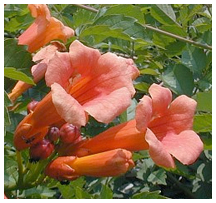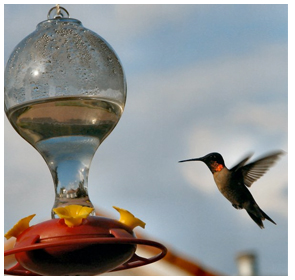
Invite a hummer to share your garden
Hummingbirds live only in the Americas. Of the 338 species known, 16 are found in the United States and 3 occur in Florida. Black-chinned and rufous hummingbirds occasionally can be seen in Florida during the winter. The ruby-throated hummingbird is by far the most common hummer in the state.
This feathered jewel is about 3 inches (7.5 centimeters) long and weighs as little as a penny (¼ ounce). Its name describes the most brilliant part of the mature male’s plumage. The throat feathers contain air bubbles that give off an iridescent red tone in full light. Both sexes, young and mature birds, have metallic green backs and white-tipped tail feathers.
The ruby-throat’s breeding range extends from central Kansas to the east coast and from Saskatchewan to central Florida. Although some birds may stay in south Florida year-round, most winter in Mexico and South America. Males arrive in Florida in March. Females arrive about a week later.
Ruby-throated hummingbirds are most attracted to nectar-rich plants having bright red or orange blossoms of tubular shape. You will have to choose your plants carefully – many of the popular, nonnative landscape plants are unsuitable for nectar-seekers.
Stick with flowering natives as much as possible, especially trees, shrubs, vines and perennials, which will require a minimum of care. Annuals, on the other hand, must be replaced each year. Single-flowered blossoms have more nectar than double ones, so avoid double-flowered and sterile hybrids.
Hummingbirds feed most comfortably from blossoms two feet or higher above the ground. They will also visit hanging potted plants and sugar-water feeders on open patios and porches. Be sure to consider the best viewing opportunities your windows and porches afford as you place your hummingbird garden or plants. Remember, too, that flowering plants nearly always require full sun.

Artificial feeders: use with caution
The safest, most balanced way to encourage hummingbirds is to provide their favorite nectaring blossoms in sunny habitats. But, as most hummer fans know, sugar-water feeders are usually a sure draw for these birds. If you choose to supplement the birds’ natural diet in this way, protect them from hazardous, spoiled solutions by observing the following safety tips:
• DO use a feeding solution of four parts water to one part white granulated sugar – no stronger. Bring water to a full boil, dissolve in sugar and promptly cool. Refrigerate unused portions.
• DO choose feeders that can be dismantled and thoroughly cleaned to remove bacteria and fungus molds. Scrub with hot water and vinegar (no soap) every four or five days.
• DO NOT use honey. It may contain botulism toxins and fungi fatal to hummingbirds.
• IT IS NOT necessary to use colored solutions when using red-colored plastic feeders.
• DO NOT use insect sprays to control bees, wasps or ants on feeders. Vegetable oil applied around the feeder openings and on the suspending wire should discourage these unwanted visitors. Many commercially available feeders come equipped with plastic bee guards.
Hummingbird gardens
An excellent planting design for a hummingbird garden follows the wildlife landscaping principle of layered vegetation. Build a cascade of plant attractants by securing a trellis to a wall and covering it with trumpet creeper or coral honeysuckle vines. Or consider a red buckeye for height at the back of your hummingbird garden. Add lower shrubs such as coral bean or fire bush, and then low flowering annuals and perennials closest to the ground.

Margaret Arnold
July 7, 2011I am a new hummingbird watcher…
Do hummingbirds hang around Northwest Florida during May June July August?
Walton Outdoors
July 7, 2011Yes, the ruby-throated hummingbird spends the summer in Northwest Florida.